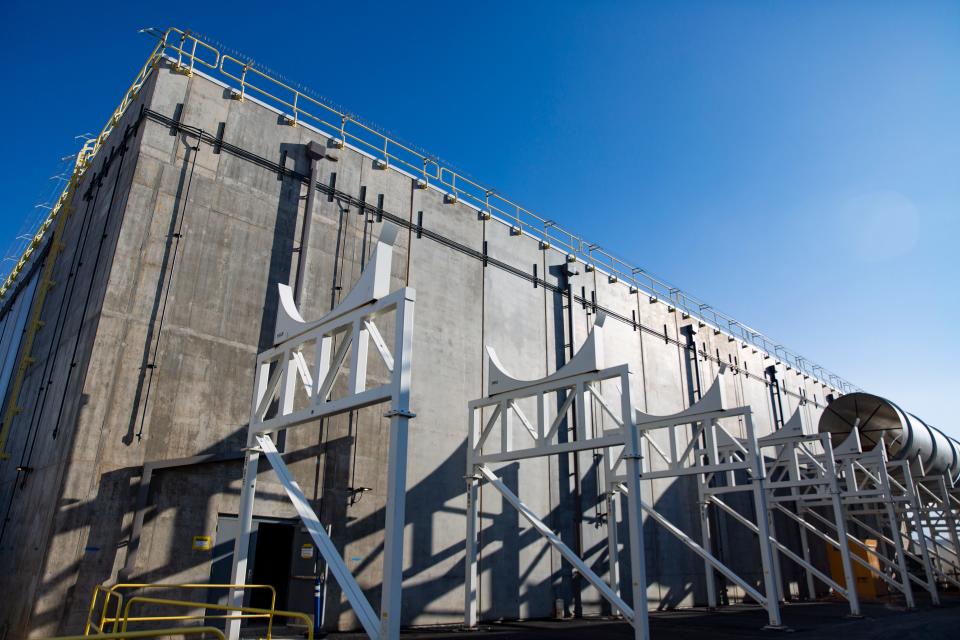Cable snaps inside utility shaft at WIPP, pausing work for now
Federal officials are unsure of when construction will resume on a new air shaft at the nuclear waste repository outside of Carlsbad, after an incident in November led to a halt of the project.
A material handling basket being lifted through the shaft became misaligned, colliding with the edge of the shaft and snapping the hoisting cable, causing the basket to fall about 2,150 feet down the shaft, according to a Dec. 1 report from the Defense Nuclear Facilities Safety Board.
The Board report indicated that the incident was caused when workers with subcontractor Harrison Western Shaft Sinkers failed to implement required controls for hoisting and rigging operations, instead “relying on informal operator actions which proved ineffective.”
More: Cold War nuclear waste is prioritized at Carlsbad-area repository. How much is there?
The Defense Nuclear Facilities Board said this latest event was the third hoisting-related incident at the shaft in about a month.
The incident led to a stop work order, the report read, as of Friday officials were still unsure of when the work will resume, said George Rangel, spokesman for Salado Isolation Mining Contractors (SIMCO), the federal contractor overseeing operations at the Waste Isolation Pilot Plant.
No radioactive materials were involved in the incident, and no one was injured.
More: Janell Whitlock, John and Julia Heaton inducted into Carlsbad Hall of Fame
“WIPP is taking a measured and phased approach to safely resuming full work activities at the new Utility Shaft,” said Mark Bollinger, manager of the Department of Energy’s Carlsbad Field Office in an emailed statement.
“We’ve begun a detailed surface and underground inspection of the shaft and equipment. Following the inspections, any repairs that may be needed will be completed.”
Bollinger said the DOE and SIMCO were working with the subcontractor to prevent future incidents and make needed repairs to the shaft.
More: More than 400 shipments of nuclear waste came to Carlsbad-area repository in 2023
“In the meantime, DOE’s Carlsbad Field Office and our contractor, Salado Isolation Mining Contractors, are working with the Utility Shaft subcontractor to implement corrective actions,” Bollinger wrote. “Full work on the Utility Shaft will resume only after any necessary corrective actions have been implemented.”

Other incidents, according to the board’s Nov. 3 report included a “mishap” where a rigging cable rubbed against a spool guide, causing the wire to break on a tugging device connected to a skid steer loader vehicle.
In October, the Board also reported another skid steer loader vehicle swung uncontrollably and struck the shaft’s scaffolding platform known as the Galloway.
More: Final testing underway at $486M air system for nuclear waste site near Carlsbad
A new hoisting and rigging plan was being developed in response to those incidents, read the report.
No one was injured in either event, records show.
The new shaft, the fifth at WIP, was designed to act as an air intake at the site and provide access to new areas of the underground being mined to additional waste disposal.
The waste is brought to WIPP, located about 30 miles east of Carlsbad, via truck from Department of Energy sites around the country.
More: A nuclear reactor in Carlsbad? City officials call for project at federal waste repository
The waste is made up of clothing materials, equipment and other debris irradiated during federal nuclear operations known transuranic (TRU) nuclear waste, which is dispose of via burial in WIPP’s 2,000-foot-deep salt deposit.
To do this, workers must mine underground, while maintaining the facility and emplace the waste.
These operations were restricted in 2014 after an accidental radiological release contaminate parts of the mine and limited available airflow.
More: Oil & gas industry joins fight against nuclear waste site proposed in southeast New Mexico
The shaft, combined with another project to rebuild WIPP’s ventilation system was expected to increase the site’s full air capacity from about 170,000 cubic feet per minute to 540,000 cfm, allowing maintenance, mining and waste operations to occur simultaneously.
Western Harrison Shaft Sinkers recently announced the shaft was dug to its final depth and will next be tied into the rest of the underground as two new panels are mined to replace waste disposal space lost in the 2014 event.
The shaft will also connect with the rebuilt ventilation system, a series of air filters and buildings known as the Safety Significant Confinement Ventilation System (SSCVS) that will filter air breathed by workers and exhaust it out of the facility.
Together, the project will increase safety in the underground said Michael Gerle, environmental regulatory compliance director with the CBFO.
“The SSCVS will enhance the quantity, and quality, of air flow for our workforce in the WIPP underground mine,” he said in a statement. “Additionally, the new infrastructure will ensure our operations remain safe for the environment and the public.”
Adrian Hedden can be reached at 575-628-5516, achedden@currentargus.com or @AdrianHedden on the social media platform X.
This article originally appeared on Carlsbad Current-Argus: Work on WIPP's air shaft halted following safety incidents

